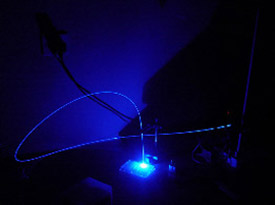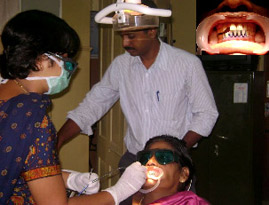
Antimicrobial Photodynamic Therapy
The presence of bacterial biofilm on the tooth or root surface is a major cause of gingivitis and periodontitis. Mechanical removal of biofilm, adjunctive use of antibiotics and surgery are conventional methods of periodontitis therapy. In the light of recent reports about bacterial strains becoming resistant to frequent doses of antibiotics researchers are currently investigating the use of antimicrobial photodynamic therapy (aPDT) as an alternative to antibiotic drugs in the treatment of periodontal infections. During aPDT, intense light irradiation of affected lesion after application of photosensitizing dyes induces phototoxic reactions, which release oxygen free radicals that selectively destroy the bacterial cells.
As part of this Indo-Bulgarian collaborative project it is proposed to develop technologies and treatment modalities for photo-inactivation of periodonto-pathogenic bacteria. The study involves identification of pathogenic bacteria (aerobic and anaerobic) present in periodontal pockets of local population, their culture and photo-inactivation in the presence of suitable non-toxic photosensitizers both under in vitro and in vivo conditions (Fig. 1).
A clinical trial has been initiated at the Govt Dental College to test the potential of using diffuse reflectance imaging detect and monitor periodontal infection by comparison with pocket depth and gingival inflamation. In patients diagnosed with aggressive periodontitis, PDT is performed (Fig. 2) with methylene blue as sensitizer at 10mg/mL and a laser (655nm) irradiation dose of 60 mW/cm2.

Fig. 1. Antimicrobial PDT of E. Fecalis bacteria in vitro in the presence of riboflavin

Fig. 2. Clinical trial for treatment of aggressive periodontitis using aPDT. The inset a close-up of the gingiva after application of the methylene blue.




 RTI Act
RTI Act